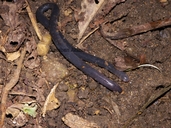|
Caecilia occidentalis Taylor, 1968
Cauca Caecilian | family: Caeciliidae genus: Caecilia |
| Species Description: Taylor, E. H. (1968). The Caecilians of the World: A Taxonomic Review. Lawrence: University of Kansas Press. | |
 © 2011 Esteban Alzate (1 of 1) |
|
|
|
Description DIAGNOSIS: Caecilians can be diagnosed via the following characteristics: location of the tentacle relative to the nostrils and eyes, presence of primary, secondary, and tertiary grooves, shape of the cloaca, the presence of a tail, and coloration (Lynch 2009). Caecilians in the Caeciliidae family lack true tails, have grooves, rounded ends to their bodies (Wilkinson and Nussbaum 2006), imperforate stapes, inner mandibular teeth, eyes that are surrounded or covered by the maxillopalatine, and only monocusped teeth (Wilkinson et al. 2011). Caecilia occidentalis resembles Caecilia subterminalis; however, C. occidentalis has more primary grooves than C. subterminalis (Lynch 2009). Caecilia occidentalis can be differentiated from C. goweri as the latter has more secondary grooves that may fully encircle the body (Fernández-Roldán and Lynch 2022). COLORATION: In life, C. occidentalis appears black or blue (Lynch 2009, Fernández-Roldán and Lynch 2022). In preservative, C. occidentalis also has a cream or yellow colored lateral stripe that is best defined anteriorly and posteriorly and becomes reduced to a broken line or completely absent in the middle (Taylor 1969). Preserved specimens have also been recorded to have cream or yellow spots located on the head (Taylor 1969). Distribution and Habitat Country distribution from AmphibiaWeb's database: Colombia
Life History, Abundance, Activity, and Special Behaviors The growth of C. occidentalis predominantly involves increasing the length of the body while the head and body width only increases little in proportion to the degree of the body lengthening (Taylor 1969). It is believed that C. occidentalis is oviparous (Wake and Case 1975). Trends and Threats Relation to Humans Possible reasons for amphibian decline General habitat alteration and loss Comments PHYLOGENETIC RELATIONSHIPS: Caecilia occidentalis was determined to be a unique species based on morphology (Taylor 1969).Caecilian taxonomy is unstable due to small sample sizes; some species only have one specimen. Consequently, attempts to understand caecilian taxonomy rely on a handful of morphological characters and there is an incomplete understanding of variation (Gower and Wilkinson 2005). As of 2011, the family Caeciliidae is compose of the genera, Caecilia, and Oscaecilia, with the next more closely related family being Typhlonectidae (Wilkinson et al. 2011) References Fernández-Roldán, J.D., and Lynch, J.D. (2022). On the geographic distribution of the caecilians Caecilia goweri and Caecilia occidentalis. Herpetological Bulletin, 162, 30-31. [link] Gower, D.J. and Wilkinson, M. (2005). Conservation biology of caecilian amphibians. Conservation Biology, 19(1), 45-55. [link] IUCN SSC Amphibian Specialist Group. (2019). Caecilia occidentalis. The IUCN Red List of Threatened Species 2019: e.T59522A49354812. https://dx.doi.org/10.2305/IUCN.UK.2019-3.RLTS.T59522A49354812.en. Accessed in May 2022 Lynch, J. D. (1999). Una aproximación a las culebras ciegas de Colombia (Amphibia: Gymnophiona). Revista de la Academia Colombiana de Ciencias Exactas, Físicas y Naturales, 23, 317–337. [link] Ramírez-Chaves, H.E., Pérez, W.A., Mejía-Egas, O., Tobar-Tosse, H.F., Muñoz, A. and Trujillo Lozada, A. (2010). Biodiversidad en el campus de la Universidad del Cauca, Popayán, Colombia. Biotecnología en el Sector Agropecuario y Agroindustrial, 8(2), 104-117. [link] Taylor, E.H. (1969). On the status of Caecilia occidentalis Taylor. The University of Kansas Science Bulletin, 48, 785–790. [link] Wake, M.H. and Case, S. M. (1975). The Chromosomes of Caecilians (Amphibia: Gymnophiona). Copeia, 1975(3), 510–516. [link] Wilkinson, M., and Nussbaum R.A. (2006) Caecilian Phylogeny and Classification. In J.-M. Exbrayat (Ed.) Reproductive Biology and Phylogeny of Gymnophiona: Caecilians Volume 5 (pp. 39–78). Science Publishers [link] Wilkinson, M., San Mauro, D., Sherratt, E., and Gower, D. J. 2011. A nine-family classification of caecilians (Amphibia: Gymnophiona). Zootaxa 2874: 41-64. [link] Originally submitted by: Amy Wu (2023-07-11) Description by: Amy Wu (updated 2023-07-11)
Distribution by: Amy Wu (updated 2023-07-11)
Life history by: Amy Wu (updated 2023-07-11)
Trends and threats by: Amy Wu (updated 2023-07-11)
Relation to humans by: Amy Wu (updated 2023-07-11)
Comments by: Amy Wu (updated 2023-07-11)
Edited by: Ann T. Chang (2023-07-11) Species Account Citation: AmphibiaWeb 2023 Caecilia occidentalis: Cauca Caecilian <https://amphibiaweb.org/species/1864> University of California, Berkeley, CA, USA. Accessed Apr 20, 2024.
Feedback or comments about this page.
Citation: AmphibiaWeb. 2024. <https://amphibiaweb.org> University of California, Berkeley, CA, USA. Accessed 20 Apr 2024. AmphibiaWeb's policy on data use. |


 Map of Life
Map of Life